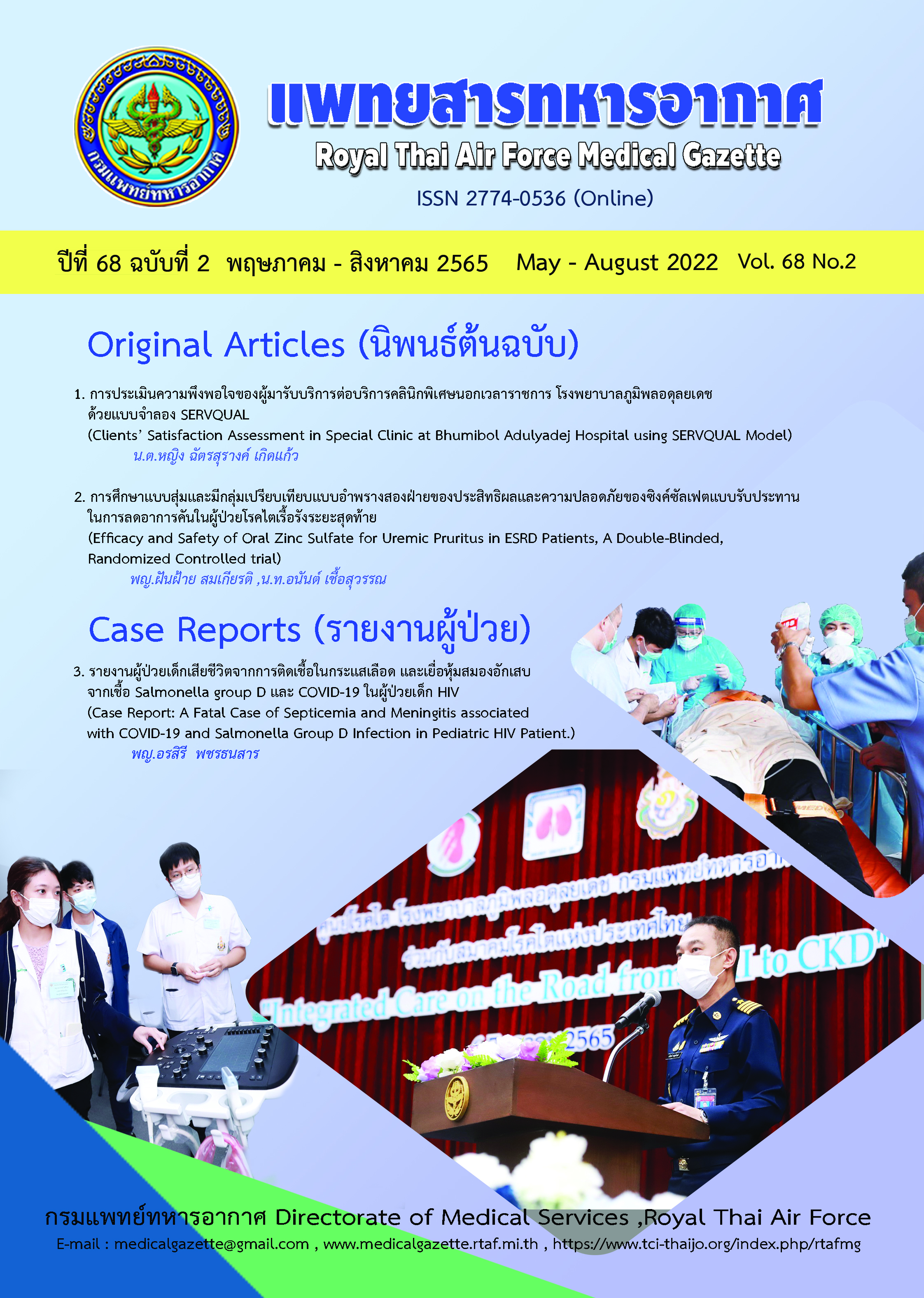Efficacy and safety of oral zinc sulfate for uremic pruritus in ESRD patients, A double-blinded, randomized controlled trial
Main Article Content
Abstract
Background Persistent itch or “Pruritus” has been one of deliberating symptoms burdening chronic kidney disease (CKD) patients and leads to poor quality of life (QOL). Previous evidence reported that the calcium channel type Cav3.2 is upregulated in the skin of CKD stage 5 patients leads to decreased threshold in sensing the itch stimuli and zinc can decrease the activity of this channel. Zinc is also supposed to inhibit the release of histamine. An eight week course of oral zinc sulfate 440 mg/day is found to be effective in relieving pruritus in hemodialysis patients from a double blind, randomized controlled trial conducted in 40 Iranian patients without serious adverse effect, but there is no information about zinc level or any correlation between zinc level and pruritus symptom.
Methods This study aims to confirm the efficacy of oral zinc sulfate in relieving pruritus in Thai ESRD patients as the primary outcome. The correlation between zinc level and pruritus, the efficacy of oral zinc sulfate in improving QOL, and adverse effects from the drug were the secondary outcomes. Patients were randomly allocated to receive zinc sulfate capsule 440 mg/d (220 mg bid) or identical placebo for 12 weeks and off-treatment for 4 weeks. The intensity of pruritus and QOL were evaluated by the Visual Analogue Scale (VAS) and the Uremic Pruritus in Dialysis Patients (UP-Dial) scale consequently every 4 weeks. Decreasing of 3 points or more from baseline VAS implies significant improvement.
Results Total of 55 patients were allocated to 2 groups, 28 received oral zinc sulfate while 27 received placebo with similar demographic profile, adequate maintenance dialysis (Kt/V: 1.66±0.31 vs. 1.65±0.28, respectively). There were significant difference in the initial VAS score (7.00±1.90 vs. 5.63±2.09) and serum Zinc level (58.50±9.46 vs. 63.00±7.15 ug/dL) between both groups. Although the mean difference of VAS score from the baseline was more in the zinc group (1.41; 95%CI, 0.095-2.732 ; p=0.036) at 4th week of the trial, there was no difference in degree of changed VAS score at 12th week and off- treatment phase at 16th week [1.131 (95%CI ,-0.423-2.684; p=0.150) and 1.505 (95%CI ,-0.142-3.152; p=0.0724) respectively]. We found no correlation between zinc level or change in zinc level and VAS score. There was also no difference between both groups in improving QOL. Adverse effects were not statistically different.
Conclusion Our study showed no difference between oral zinc sulfate and placebo in relieving pruritus in ESRD patient. Further trials are needed with more participants and monitoring of zinc level at 4th week.
Article Details

This work is licensed under a Creative Commons Attribution-NonCommercial-NoDerivatives 4.0 International License.
บทความที่ได้รับการตีพิมพฺเป็นลิขสิทธิ์ของวารสาร
References
2.Verduzco HA, Shirazian S. CKD-Associated Pruritus: New Insights Into Diagnosis, Pathogenesis, and Management. Kidney Int Rep. 2020;5(9):1387-1402. Published 2020 May 8. doi:10.1016/j.ekir.2020.04.027
3.Momose A, Yabe M, Chiba S, Kumakawa K, Shiraiwa Y, Mizukami H. Role of Dysregulated Ion Channels in Sensory Neurons in Chronic Kidney Disease-Associated Pruritus. Medicines (Basel). 2019;6(4):110. Published 2019 Nov 13. doi:10.3390/medicines6040110
4.Matsumoto M. Pruritus and mast cell proliferation of the skin in end stage renal failure. Clinical Nephrology. 1985;23(6):285–8.
5.Sanada S. Beneficial effect of zinc supplementation on pruritus in hemodialysis patients with special reference to change in serum histamine levels. Hinyokika kiyo. 1987;33(12):1955–60.
6.Najafabadi MM. Zinc Sulfate for Relief of Pruritus in Patients on Maintenance Hemodialysis. Therapeutic Apheresis and Dialysis. 2012Sep;16(2):142–5.
7.Nochaiwong S. Clinical interpretation of the Uremic Pruritus in Dialysis Patients (UP-Dial) scale: a novel instrument for the assessment of uremic pruritus. Journal of The European Academy of Dermatology and Venereology. 2018Jul;32(7):1188–94.
8. Bernard, R. (2000). Fundamentals of biostatistics (5th ed.). Duxbery: Thomson learning, 308.
9. Ngamjarus C., Chongsuvivatwong V. (2014). n4Studies: Sample size and power calculations for android. The Royal Golden Jubilee Ph.D. Program - The Thailand Research Fund&Prince of Songkla University.
10.Massry SG, Popovtzer MM, Coburn JW, Makoff DL, Maxwell MH, Kleeman CR. Intractable pruritus as a manifestation of secondary hyperparathyroidism in uremia. Disappearance of itching after subtotal parathyroidectomy. N Engl J Med. 1968;279(13):697-700.
11.Narita I, Iguchi S, Omori K, Gejyo F. Uremic pruritus in chronic hemodialysis patients. J Nephrol. 2008 Mar-Apr;21(2):161-5.
12.Moniaga CS, Tominaga M, Takamori K. Mechanisms and Management of Itch in Dry Skin. Acta Derm Venereol. 2020;100(2):adv00024. doi:10.2340/00015555-3344
13. Morton CA, Lafferty M, Hau C, Henderson I, Jones M, Lowe JG. Pruritus and skin hydration during dialysis. Nephrol Dial Transplant. 1996;11(10):2031-2036.
14. Dashti-Khavidaki S, Khalili H, Vahedi SM, Lessan-Pezeshki M. Serum zinc concentrations in patients on maintenance hemodialysis and its relationship with anemia, parathyroid hormone concentrations and pruritus severity. Saudi J Kidney Dis Transpl. 2010 Jul;21(4):641-5.
15. Unhapipatpong C. Alcoholic Cirrhosis with Zinc and Copper Co-Deficiency. Case reports in Clinical Nutrition. 2019Apr4;2:8–15.


